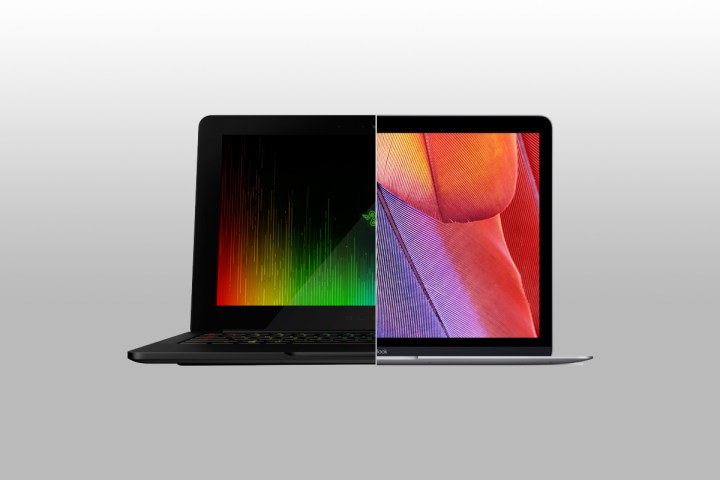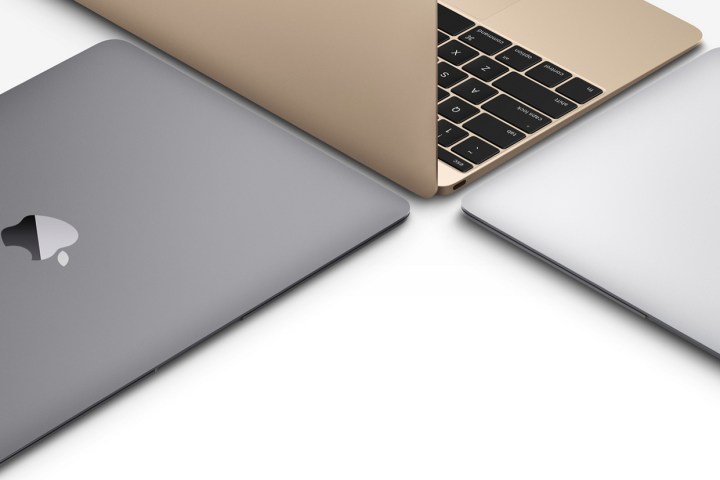
Which one should you spend your hard-earned money on, though? Aside from the obvious difference in operating systems, the Blade Stealth and the new MacBook differ on design principles. While they’re both extremely stylish and fairly light in terms of expansion capabilities — the Core notwithstanding — the MacBook is designed as an object of absolute minimalism to allow for the thinnest, lightest build possible. The Blade Stealth is still tiny compared to most laptops, but its Core i7 processor and generous collection of ports makes it appealing to power users.
Let’s take a good, hard look at the similarities and differences between these two machines.
|
Apple MacBook (2015) |
Razer Blade Stealth (Late 2015)  |
|
| Dimensions | 11.04 x 7.74 x 0.14-0.52 (in) | 12.6 x 8.1 x 0.52 (in) |
| Weight | 2.03 pounds | 2.75 pounds |
| Keyboard | Full size, backlit keyboard | Full size, RGB “Chroma” backlit keyboard |
| Processor | Intel Core M (4M Cache, up to 2.4 GHz) | Intel Core i7-6500U Processor (4M Cache, up to 3130 GHz) |
| RAM | 8GB of 1600MHz LPDDR3 | 8GB of 1866MHz LPDDR3 |
| Graphics | Intel HD Graphics 5300 | Intel HD Graphics 520 |
| Display | 12-inch LED-backlit display with IPS technology | 12.5-inch LED-backlit IPS touchscreen |
| Resolution | 2304 x 1440 | 2560 x 1440 or 3840 x 2160 |
| Storage | 256GB/512GB SSD | 128GB/256GB/512GB SSD |
| Networking | 802.11ac, Bluetooth 4.0 | 802.11ac, Bluetooth 4.1 |
| Ports | USB Type-C/Thunderbolt, HDMI, headphone jack | USB 3.0, USB Type-C/Thunderbolt, HDMI, headphone jack |
| Webcam | 480p FaceTime camera | 2-megapixel webcam |
| Operating System | Mac OS X El Capitan | Windows 10 |
| Battery | 39.7-watt-hour | 45-watt-hour |
| Price | $1,300+ | $1,000+ |
| Availability | Now | Now |
| Review | 3.5 out of 5 | 3.5 out of 5 |
Specifications
The biggest difference between the MacBook and the Blade Stealth is processor architecture. The latter is designed to support high-end PC gaming, at least when connected to the sold-separately Core, so it uses the latest generation Core i7-6500U processor with a top clock speed of 3.1GHz. In contrast, the MacBook uses a lightweight Core M processor with top speeds of 2.4GHz or 2.6GHz, depending on the model.
The Apple laptop simply can’t compete with Razer’s performance-focused choice. The MacBook’s integrated Intel HD Graphics 5300 GPU isn’t up to much, either… but then neither is the Blade Stealth’s Intel HD Graphics 520, which it relies upon in lieu of the Core. Both machines can handle standard Web graphics, some very light gaming, and external displays, but not much else. Reviewers note that the MacBook’s processor power is especially poor.
All models of the Blade Stealth come with 8GB of RAM, as do the various MacBook tiers, so they’re on even footing there. The $1,000, entry-level model of the Blade Stealth packs a 128GB SSD, while the MacBook gets 256GB in its $1,300 starter package. Both can be upgraded to 512MB, which costs $1,600 on both sides of the aisle. Neither the Blade Stealth nor the MacBook have user-accessible RAM or SSD drives, so what you pay for is what you’ll be stuck with for the life of the laptop.

Display
In terms of screens, the MacBook comes with one option, a very serviceable 12-inch IPS panel with 2,304 by 1,440-pixel resolution. The Blade Stealth has two options: the base model with a 12.5-inch, 2,560 x 1,440-pixel screen, and the 4K 3,840 x 2,160-pixel panel that begins with the $1,400 model. While the upgraded screen is nice, it’s hard to imagine that it’s all that useful on such a small laptop — the bigger SSD at the $1,600 price point would seem to be the only reason to upgrade.
The Blade Stealth also touts a touch-sensitive display on all models, whereas the MacBook does not.
Portability
The MacBook comes with an integrated, 39.7-watt-hour battery. Apple claims that this will give users up to nine hours of Web browsing, but reviews have shown it typically get six to eight.
While that is considerably poorer than the MacBook’s spiritual ancestor the Air, the Blade Stealth doesn’t do any better. Even on its larger 45-watt-hour battery, the ultrabook’s more powerful processor sucks it dry in just under four hours, which is a poor score compared to some of Razer’s Windows-powered competition.
Neither machine is particularly well-suited for long hours away from a wall outlet, but the MacBook is the winner between them.
Connectivity
If Apple wins a clear victory for longevity, Razer gets a blowout on expansion. Even if you’re not planning on splurging for the Core and an external video card, the Blade Stealth offers two standard USB 3.0 ports and a USB Type C port — which works for data and video via Thunderbolt and also doubles as the power input — along with full-sized HDMI 1.4 and a headphone jack.
While it lacks some extras such as an SD card slot or Ethernet port, it’s offers far more than the MacBook’s minimal setup, which consists of one USB Type C port (for data, power, and video) and a headphone jack. Users need sold-separately adapters even for standard USB or HDMI.
Design
Razer’s Blade series has always borrowed from Apple, as the laptops tend to look like blacked-out MacBooks with a green snake logo instead of an apple (there may be some unresolved theological issues there). The Blade Stealth is no different, and looks more like Batman’s take on the MacBook Air than anything else. It’s certainly stylish, not to mention tiny, with a vertical height of just 13.1 millimeters. The full aluminum body and restrained green-on-black color scheme don’t hurt, either.

However, the MacBook’s visual appeal is undeniable. The laptop’s aluminum body measures 13.1 millimeters at its thickest point and 11.04 inches wide, which is noticeably smaller than the 12.6-inch Blade Stealth. The Stealth has speakers flanking its keyboard, though, while the MacBook moves them to the top of the base. The Apple laptop is also slightly lighter at 2.03 pounds, showcases more graceful body lines, and comes in either silver, gold, or space grey. The MacBook wins in looks, even if it’s only a relative victory.
Usability is another matter. Both laptops offer excellent screens in similar sizes, but the Blade Stealth’s chicklet keyboard gives it an advantage when typing. It’s nothing to write home about in terms of comfort, though the ability to configure the color of each key using RGB backlighting — and sync it via Razer’s Chroma software — is interesting. The MacBook’s keyboard is backlit, but the almost non-existent key travel means that typing for any extended amount of time can be quite uncomfortable.
Availability and price
The Blade Stealth is currently available in four models: $1,000 for the standard QHD screen and a 128GB SSD, $1,200 for a 256GB upgrade, $1,400 for the same SSD with a 4K screen, and $1,600 for 512GB and 4K. The processor and RAM options are constant across all models. The MacBook starts at $1,300, but offers the same 256GB SSD and 8GB of RAM as Razer’s $1,200 model. The only other option is $1,600, which ups the storage to 512GB and replaces the 1.1GHz Core M processor with a barely-noticeable 1.2GHz upgrade.
While Razer and Apple offer similar configuration options at both $1,200 to 1,300 and $1,600, Razer’s $1,000 entry model hits the magic number. More granular price options, plus the better processor, touchscreen, extra ports, and optional 4K resolution make it a clear winner in terms of price. That puts Razer in a surprising position, given it’s rarely the more economical option.
Conclusion
Assuming buyers are fairly agnostic when it comes to operating systems (or willing to pay for a Windows license and dual-boot the MacBook), the Razer Blade wins most points in this competition. Its superior processor architecture, more flexible expansion options, and more comfortable keyboard make it a better choice for anyone looking for a work-focused ultraportable. It might come from a gaming company, but this little battler can hang with the big boys. Buyers also have the option of PC gaming with the $500 Core add-on, plus a graphics card.
There’s an exception, however. If you often spend hours and hours unplugged, the MacBook’s undeniable battery advantage means it does better as a road warrior. It’s also the more stylish of the two thanks to Apple’s design work and a choice of three colors. If you need longer battery life — and don’t mind the port limitations — then pass on the snake and pick the Apple.



